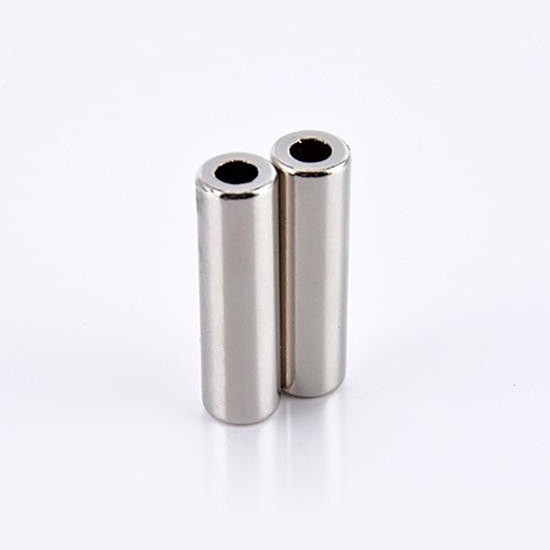What are the safety precautions when handling cylindrical magnets?
 Jun 30, 2025|
Jun 30, 2025| When dealing with cylindrical magnets, safety is of paramount importance. As a supplier of cylindrical magnets, I've seen firsthand the potential risks associated with these powerful magnetic objects. In this blog, I'll share some crucial safety precautions to ensure that you handle cylindrical magnets safely and effectively.


Understanding the Basics of Cylindrical Magnets
Before delving into safety precautions, it's essential to understand what cylindrical magnets are. Cylindrical magnets are a type of permanent magnet with a cylindrical shape. They are widely used in various industries, including electronics, automotive, and manufacturing. These magnets come in different sizes and strengths, and they can be made from various materials, such as neodymium, ferrite, and samarium cobalt.
There are different types of cylindrical magnets available in the market. For instance, Cylindrical Permanent Magnet offers a high level of magnetic strength and stability. Hollow Cylinder Magnets are useful in applications where weight reduction or the passage of other objects through the magnet is required. And Magnet Cylindrical is a general term that encompasses a wide range of cylindrical magnet products.
Physical Safety Precautions
Pinch Points and Impact Risks
One of the most significant dangers when handling cylindrical magnets is the risk of pinch points. Cylindrical magnets can exert a very strong magnetic force, especially neodymium magnets. When two magnets are brought close to each other, they can snap together with great force. This sudden movement can cause severe pinching injuries to fingers or other body parts caught between them.
To avoid such injuries, always handle magnets with care. Use non - magnetic tools, such as plastic or wooden tweezers, to separate or move small magnets. When working with larger magnets, it's advisable to wear protective gloves. If you need to bring two magnets close to each other, do it slowly and at a controlled pace, ensuring that your fingers and other body parts are well - clear of the potential pinch points.
In addition to pinch points, magnets can also cause impact injuries. If a magnet is dropped or allowed to fly towards another metal object due to magnetic attraction, it can hit with significant force. This can damage the magnet, the object it hits, and potentially cause injury to nearby people. Therefore, always keep a safe distance from areas where magnets might move suddenly and secure them properly when not in use.
Chipping and Fragmentation
Cylindrical magnets, especially those made of brittle materials like neodymium, can chip or break when subjected to sudden impacts or excessive force. These chips and fragments can be sharp and pose a cutting hazard. When handling magnets, avoid dropping them or subjecting them to rough handling.
If a magnet does break, be extremely careful when cleaning up the fragments. Wear safety goggles and gloves to protect your eyes and hands from the sharp pieces. Use a non - magnetic container to collect the fragments and dispose of them properly according to local regulations.
Electrical and Electronic Safety
Interference with Electronic Devices
Cylindrical magnets can interfere with the normal operation of electronic devices. The magnetic field generated by the magnets can disrupt the magnetic storage media in devices such as hard drives, credit cards, and magnetic ID cards. It can also affect the performance of electronic sensors, compasses, and other sensitive electronic components.
When working with cylindrical magnets, keep them away from electronic devices. If you need to use magnets in an environment with electronic equipment, ensure that proper shielding is in place. Magnetic shielding materials can be used to reduce the magnetic field's influence on nearby electronics.
Electrical Hazards
In some cases, magnets can be part of electrical circuits or interact with electrical currents. For example, in electric motors or generators, magnets play a crucial role. When handling these types of magnets, it's important to follow electrical safety procedures.
If you are working on a circuit that involves magnets, make sure the power is turned off before making any adjustments or handling the magnets. This helps prevent electrical shocks and short - circuits. Also, be aware of the potential for induced currents in nearby conductors due to the changing magnetic field of the moving magnets.
Chemical Safety
Coating Integrity
Many cylindrical magnets are coated to protect them from corrosion and to improve their appearance. However, if the coating is damaged, the magnet material may be exposed to the environment, which can lead to corrosion. Some magnet materials, such as neodymium, can corrode quickly when exposed to moisture or certain chemicals.
When handling magnets, inspect the coating regularly for signs of damage. If the coating is damaged, take appropriate measures to prevent further corrosion. This may involve applying a new coating or using the magnet in a protected environment.
Toxicity
Some magnet materials, such as samarium cobalt, may contain elements that can be toxic if ingested or inhaled. Although the risk of exposure is relatively low during normal handling, it's still important to take precautions.
Wash your hands thoroughly after handling magnets, especially before eating, drinking, or touching your face. Avoid inhaling dust or fumes that may be generated during the machining or cutting of magnets. If you are involved in processes that generate magnet dust, use appropriate ventilation systems and personal protective equipment, such as respirators.
Storage and Transportation Safety
Storage
Proper storage of cylindrical magnets is crucial to maintain their performance and ensure safety. Magnets should be stored in a dry, cool place away from direct sunlight and heat sources. High temperatures can reduce the magnetic strength of some magnets over time.
When storing multiple magnets, keep them separated by non - magnetic materials, such as cardboard or plastic. This helps prevent them from attracting each other and causing damage or injury. Stacking magnets in a stable manner is also important to prevent them from falling and causing impact hazards.
Transportation
During transportation, magnets need to be packed carefully to prevent movement and damage. Use non - magnetic containers or packaging materials that can withstand the magnetic force. If transporting magnets by air, be aware of the airline's regulations regarding the transportation of magnetic materials, as they may have specific requirements to ensure the safety of the aircraft's navigation and communication systems.
Training and Awareness
Employee Training
If you are in a workplace where cylindrical magnets are used, it's essential to provide proper training to employees. Training should cover the properties of magnets, the potential hazards associated with them, and the correct handling procedures. Employees should also be trained on how to use personal protective equipment effectively.
Regular refresher courses can help reinforce safety knowledge and ensure that employees stay updated on the latest safety practices.
Public Awareness
For consumers who purchase cylindrical magnets for personal use, it's important to provide clear safety instructions. Product packaging should include warnings about the potential hazards and safety precautions. Additionally, online resources and customer support can be used to educate consumers on the safe handling of magnets.
Conclusion
Handling cylindrical magnets safely requires a comprehensive understanding of their properties and potential hazards. By following the safety precautions outlined above, you can minimize the risks associated with these powerful magnetic objects.
As a supplier of cylindrical magnets, I am committed to providing high - quality products and ensuring that our customers are well - informed about safety. If you have any questions about our cylindrical magnet products or need more information on safety precautions, please feel free to contact us. We are more than happy to assist you in your procurement and provide guidance on the safe use of our magnets. Whether you are looking for Cylindrical Permanent Magnet, Hollow Cylinder Magnets, or Magnet Cylindrical, we are here to meet your needs.
References
- "Magnet Safety Guidelines" - International Magnets Association
- "Electrical and Magnetic Safety in the Workplace" - Occupational Safety and Health Administration
- "Materials Science of Permanent Magnets" - Academic research papers on magnet materials

